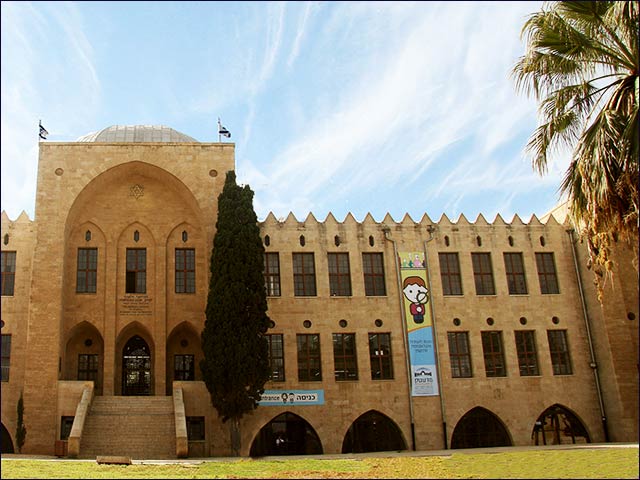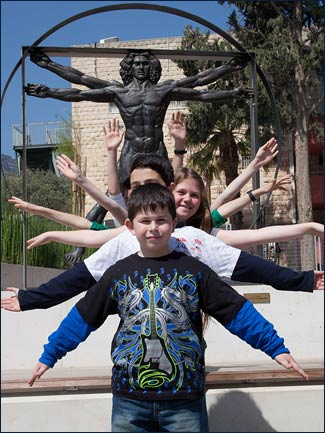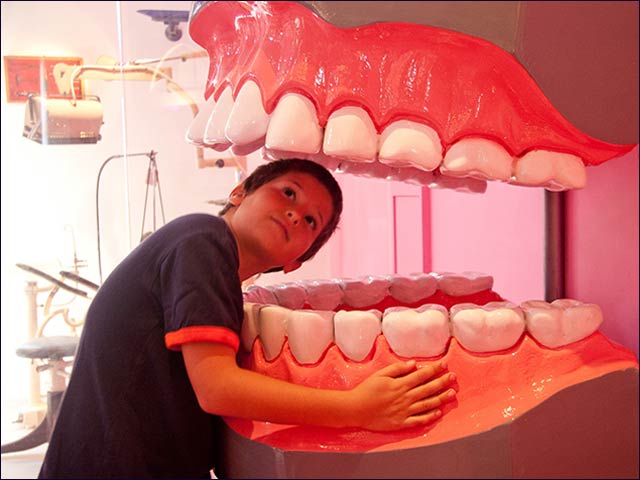By Avigayil Kadesh
“This room gets extremely noisy,” warns Eyal Amir, spokesman for MadaTech, Israel’s National Museum of Science, Technology and Space, as we enter an exhibition hall filled with engineering devices built from the drawings of Leonardo da Vinci.
“Leonardo didn’t actually build anything,” Amir explains, as he demonstrates the clanking contraptions that, miraculously, do the tasks envisioned by the Renaissance painter in his civil engineering, optics and hydrodynamics dabblings.
MadaTech, located in Haifa’s Hadar district, has a vast outdoor Noble Energy Science Park devoted to the inventions of world-great scientists da Vinci, Isaac Newton, Daniel Bernoulli, Archimedes, Galileo and Pythagoras.
Control the flow of toy ships through the series of locks based on da Vinci schemes. Channel the ancient Greek mathematician Archimedes (“Give me a fulcrum, and I shall move the world”) by using a giant lever to lift your friends inside a globe. Ride in a hand-and-foot propelled helicopter and human yo-yo to better understand aerodynamic principles pioneered by Swiss physicist Bernoulli.
Nobody expects every child coming through the museum daily – 4,000 a day during summer months – to leave with a burning desire to become a scientist.
“We won’t have young geniuses coming out of here and going straight to the Nobel Committee,” says Amir. “But we can raise their curiosity. We can make the words ‘science’ and ‘fun’ related. And fun is the most important word in a kid’s judgment. If this museum is fun, then science is fun and technology is fun. No matter what they choose to do as adults, it’s very important to have a positive attitude toward science.”
College, hospital, museum
The cornerstone of the historic building housing MadaTech’s 600 hands-on exhibits was laid by a group of German Jews in 1912. It was to be the Technicum, the world’s first academic institution teaching engineering to Jews, who were not welcome in such schools in their native countries.
 MadaTech was originally built to house the
MadaTech was originally built to house the
Technion-Israel Institute of Technology Later that vision was fulfilled in the form of the Technion-Israel Institute of Technology, but World War I intervened. The building was used as a hospital by Turkish and then British occupying forces. Finally, in 1923, Albert Einstein and his wife arrived and symbolically planted two still-flourishing palm trees on the premises. The following year, the fledgling Technion moved in.
By the 1950s the growing school had moved out all departments except architecture, which remained until 1984. That gave the national science museum, begun in two rooms at the new Technion campus elsewhere in Haifa, a home of its own. Today, many of the museum’s instructors and guides are students at the Technion or University of Haifa.
The one-acre Science Park is sandwiched between the museum and its education annex, where tens of thousands of student visitors attend classes and labs every year, says Amir.
Half of the visiting schoolchildren are Arab-Israelis, so the signage is bilingual. Overseas visitors will find that many exhibits are marked in English as well. But the youthful patrons barely give these placards a glance in any language.
“Kids don’t read explanations. They want to learn through doing. They feel it and remember it, and that’s all we want,” says Amir, as he walks through the aviation room, hall of mirrors, optical illusion exhibition and chemistry area.
“The Magic Room is one of the most fun exhibitions we have,” he continues. Here you can see the magnets, mirrors and other secrets behind classic tricks. “We show that there is no magic; it’s all science.”
The three floors of MadaTech, plus the Science Park, provide an entire day’s edutainment.
Although MadaTaf was opened to provide activities for ages two to five (“taf” means “tot” in Hebrew), the core audience is four- to 13-year-olds.

Up to 4,000 children visit MadaTech in Haifa every day You can see artifacts (such as a diary page and burned music CD) rescued from the wreckage of the 2003 space shuttle Columbia, on which Israeli astronaut Ilan Ramon lost his life. There is also a demonstration on how spacecraft remain in orbit.
In the Green Energy exhibit, you can pedal a bike to make enough electricity to send a model train around a track, use wind energy to set a small boat sailing, and see how a geothermal power plant works. (Amir relates that most of the electricity in Iceland is made from geothermal power plants designed and built in Israel.)

MadaTech’s Science of the Smile exhibition. Science of the Smile focuses on all things dental, including a tableau with an original old dental chair, x-ray machine and foot-operated drill. “The dentist who donated it said this was his job, as a kid, to operate the foot pedal as his father was drilling in someone’s mouth,” Amir relates.
The latest exhibit (2014), called Ships and the Sea, is an interactive exhibition. Visitors can explore 30 hands-on exhibits that make the world of maritime come to life.
Smaller exhibitions explore the printing press and the automobile. Various collections – old tools, cameras, microscopes, irons, sewing machines, early Edison wax cylinder recordings – line the corridors.